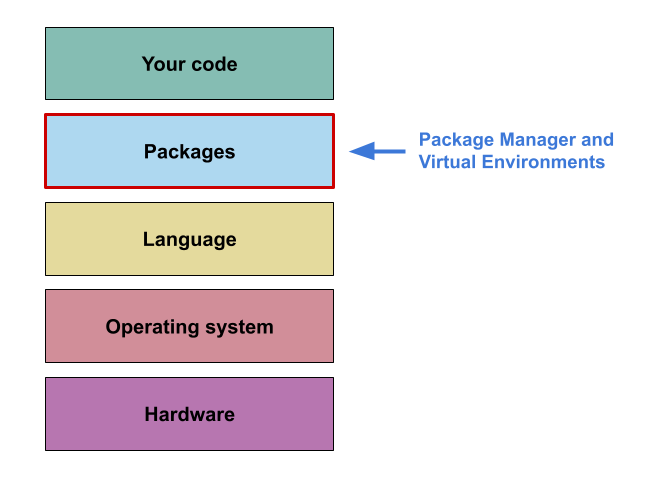Limitations
Last updated on 2025-04-15 | Edit this page
Overview
Questions
- What are the limitations of
venv? - What are the limitations of virtual environments more generally?
Objectives
- blah
Specific limitations of venv
While venv is a relatively simple option for setting up
and managing your virtual environments it does have some key
limitations:
- Python version management
- Automatically keeping track of installed packages
1. Python version management
There are differences between the different versions of Python. With the most extreme example being the incompatibility between Python2 and Python 3. Depending on the complexity of your code, changes between version may not affect you, but it can be hard to tell without trying a newer version. If you want to make your code truly reproducible you should include some information about which version of Python you used to produce your results.
venv uses whichever version(s) of Python you have
installed on your machine, but neither venv or
pip records information about which version of Python you
are using.
It is, of course, possible to include this information with the instructions on how to run your code, but as highlighted multiple times it is better to have an automated solution.
2. Automatically keeping track of installed packages
As shown, using venv with pip can create a
list of dependencies for your project, but this has to be created
manually and updated manually whenever you modify the dependencies for
your project.
Ideally this would be updated automatically as packages are added and removed, so as to avoid any mistakes or forgetting to update it after changes have been made.
Solutions
There are quite a few different tools that have been developed to
deal with these issues. Out of these the ones available, I have found
most useful to be conda/ miniforge
and uv.
These tools combine package, environment, and Python version management,
allowing you to do everything that pip and
venv do, while also being able to easily switch between
different Python versions. Both will also record the version of Python
used within an environment allowing you to capture both the ‘package’
and ‘language’ layers of your computational environment in one go.
There are some differences between them though:
conda/miniforge:
- Provide pre-compiled binaries for packages
- Includes other languages (notably R)
- They use their own package repositories, so may not be interoperable
with other Python tools without a bit of fiddling
uv:
- Uses same package repositories as pip
- Auto updating of environment dependencies file (equivalent to
requirements.txt)
- Noticably faster for installing pacakges than pip or
conda
- Not reached a v1 release yet
Up until recently I have used conda to create and manage
my Python environments, however having given uv a try
recently I am considering using it on a more permanent basis.
General limitations of virtual environments
Beyond the specific limitations of venv, virtual
environments in general have one key limitation:
- They are not able to control the underlying system they are working within.
If we go back to our diagram showing the different layers of your computational environment, you can see that virtual environments only address the layer of the environment immediately below your code.

If you are using something like conda,
miniforge or uv, then you may be able to
extand that to the ‘language’ layer. But these tools are not able to
capture the ‘operating system’ layer.
Depending on the degree of computational reproducibility you are looking for capturing the ‘package’ and ‘language’ layers may be enough. However, if you are looking for byte-for-byte reproducibility you will likely also want to capture as much of the computational environment as possible, and so you will need to turn to other tools.
Capturing the operating system layer
There are multiple different tools that can be used to capture the layer below ‘package’/ ‘language’
Virtual machines
This is one of the more commonly known tools for capturing and
replicating the ‘Operating System’ layer a computational environment.
Virtual machines (VMs) are effectively an emulation or virtualisation of
an operating within your own “host” operating system. For example, using
a virtual machine I can create and run a Windows XP operating system
within my Windows 10 machine. These can also be interacted with using
familiar point and click interfaces, and can be customised to access a
specific portion of the host machines CPU, memory, disk, etc.
It is possible to take a snapshot of an exiting VM for distribution, or
use an ‘Infrastructure
as code’ tool such as Ansible to
write a script to recreate a specific environment (e.g. install specific
software, etc)
Containers
Containers are similar to Virtual machines in that they virtualise an
operating system, but containers are typically more lightweight than VMs
as they only contain software and files that are explicitly defined in
order to run the project contained within them.
They also typically don’t have a GUI in the same way the OS on your
computer does (although some containers will provide an interface,
e.g. RStudio Server).
If you want to create an environment on your machine and then run it on
something more powerful (like a HPC) then containers are a good way of
achiving this.
Nix/Guix
Nix(OS) and Guix also provide a way of capturing the
computational environment below the ‘packages’ and ‘language’ layers,
but take a slightly different approach to this than VMs and
Containers.
These are package managers based on the idea declarative configurations,
that is: “specify your setup with a programmable configuration file, and
then let the package manager arrange for the software available on the
system to reflect that”.
This is similar to what pip is doing with the
requirements.txt file described previously, but for an
entire Operating system. However, this approach takes it one step
further by allowing multiple versions of the same package to exist on a
machine simultneously.
For a more complete outline of this approach see this post

